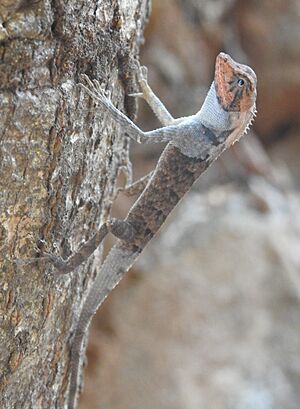Roux's forest lizard facts for kids
Quick facts for kids Roux's forest lizard |
|
|---|---|
 |
|
| Conservation status | |
| Scientific classification | |
| Genus: |
Monilesaurus
|
| Species: |
rouxii
|
| Synonyms | |
|
|
The Monilesaurus rouxii, also known as Roux's forest lizard or the forest blood sucker, is a type of lizard. It spends its time in trees and is active during the day. This lizard is special because it is found only in the hills of peninsular India. In 2018, scientists suggested moving this species to a new group called Monilesaurus.
What's in a Name?
The lizard's specific name, rouxii, was given to honor Jean Louis Florent Polydore Roux. He was a French painter and also a naturalist, which means he studied nature.
What Does It Look Like?
The Monilesaurus rouxii can grow to be about 30 centimeters (around 12 inches) long, including its tail. However, most of them are closer to 25 centimeters (about 10 inches). Its body is an olive-brown color, and its belly is lighter. It has a dark stripe that runs along the side of its head and onto its neck. You might also see dark lines spreading out from its eyes.
This lizard has thin legs with long toes. It also has two small groups of spiky bits on each side of its neck. When it's time for breeding, the male lizards change color. The top of their head, the back of their neck, and their throat pouch turn a bright brick-red.
Where Does It Live?
The Roux's forest lizard lives only in the hills of peninsular India. This includes areas like the Western Ghats and parts of the Eastern Ghats. It also lives in the hills of the Deccan plateau.
These lizards are usually found in wet hill forests. They can live at different heights, from about 100 meters (330 feet) to 900 meters (2,950 feet) above sea level. They like various forest types, from very wet evergreen forests to forests where trees lose their leaves. This species is common and can be found widely throughout its home range.
Diet and Reproduction
The Monilesaurus rouxii is an insectivore, which means it eats insects. It hunts for its food during the day, both on the ground and up in the trees. This lizard reproduces by laying eggs, which is called being oviparous. They usually breed between April and September.


